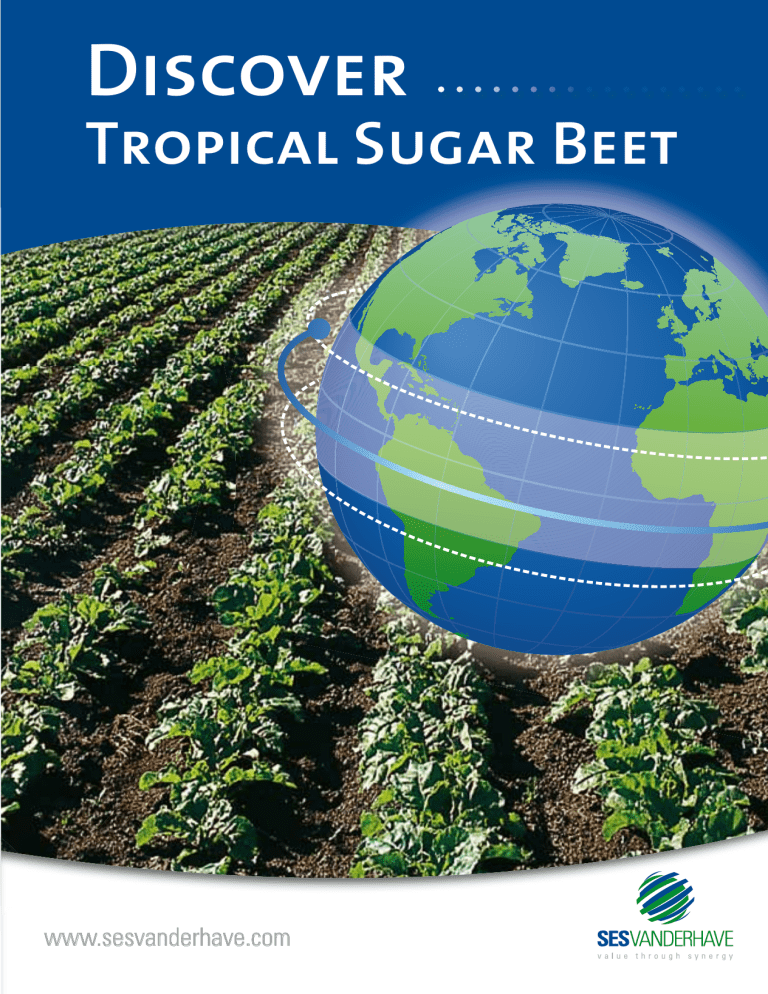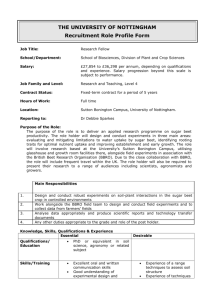
Discover Tropical Sugar Beet www.sesvanderhave.com DISCOVER ... THE TROPICAL SUGAR BEET FROM SESVANDERHAVE For decades sugar beet has been cultivated in temperate countries to produce sugar. It has always been considered as a highly profitable crop and an excellent head of the rotation. More recently, with the development of biofuels, the very high ethanol yield of sugar beet combined with the 2007 rise in cereals and crude oil prices has also renewed interest in growing sugar beet for ethanol (France & Germany). In people’s mind, sugar beet is a temperate crop that is not adapted to sugar and ethanol production in tropical regions. The recent development of sugar beet varieties able to grow in the tropics is about to change this belief... Tropical sugar beet hybrids are an evolution of sugar beets traditionally grown in extreme American and European locations (Southern California, Southern Spain, and Southern Italy). Within this genetic pool, hybrids were selected for their tolerance to heat and to diseases occurring in the tropics. SESVanderHave’s tropical sugar beets have been tested for several years in the fields, mainly by Indian Agricultural Research Institutes. In parallel we have set a breeding program both in India and in other tropical areas. Today our results are very promising: performances close to the best european yields can be achieved! Ethanol yield (liter/acre) 3 KEY BENEFITS Sugar beet has a short growing cycle (4-5 months). The farmer can therefore grow 2 different crops a year. This in turn has many positive consequences, such as a doubling of the productivity of his land or the benefits of a crop rotation. • Sugar beet has a low water requirement: about 1/3 of the water needed to grow sugar cane. This is partly due to a very deep tap root that enables the crop to use water very efficiently. • Sugar beet has a very high ethanol yield. Depending on the growing season, root yields of 25 to 30 t per acre can be achieved. This means that ethanol yields as high as 2.500 to 3.000 litres per acre can be achieved with SESVanderHave’s tropical sugar beets. 3000 SUGARBEET 2000 1000 1 2 3 4 5 6 7 8 9 10 11 12 Growing Cycle (months) Ethanol yield (liter/acre) • 3000 SUGARCANE 2000 CONCLUSION: 1 acre of tropical sugar beet produces a greater amount of ethanol than sugar cane in 1/2 the time and with 3 times less water 1000 1 2 3 4 5 6 7 8 9 10 11 12 Growing Cycle (months) MULTIPLE CO-PRODUCTS The big advantage of sugar cane is the bagasse: the fibrous residue left when sugar cane stalks are crushed. It can be used as cattle feed or sometimes as organic manure. But in India and Brazil it is increasingly used for the cogeneration of heat and power: it some cases it can meet all of the energy needed to run a factory. However it is worth knowing that sugar beet also produces several co-products with a high added-value: • • • The pulp (what is left of the root slices after raw juice extraction) can be sold or used directly on the farm as cattlefeed. It is rich in energy and high-quality proteins. Besides it shows excellent palatability. The tops & leaves (what is left in the field at harvest) are valued by farmers as a green manure and animal feed. The vinasse can be sold to farmers as organic fertilizer as well. It is a co-product of sugar beet and sugar cane distillation. As already demonstrated in France, all of these co-products can also successfully be used for the cogeneration of heat and power for instance through biomethanisation. YIELDS & CULTIVATION COSTS SWEET SORGHUM In INDIA SUGAR BEET 3 SUGAR CANE 5 12 Growing cycle months Water requirement m³/a Crop yield t/a stalk 25 root 27 stalk 28 Ethanol yield L/t stalk 50 root 100 stalk 78 L/a stalk 1250 root 2700 stalk 2184 kg/t bagasse 150 pulp (dry) 50 bagasse 300 grain 32 vinasse 57 vinasse 30 tops & leaves (dry) 49 Co-products Cultivation costs1 $/a Market price $/t 2 1600 3500 110 stalk 14400 237 10 root 381 16 stalk 25 Vasantdada Sugar Institute (VSI), 2007 1 Market prices in December 2008 2 THE TROPICAL SUGAR BEET & SWEET SORGHUM ROTATION: AN ALTERNATIVE TO SUGAR CANE IN TROPICAL AREAS India’s economy is one of the fastest developing in the world. The demand for energy is intensifying every day. Currently the country is importing about 70% of its petrol requirement. Therefore it is desperately looking for altenative - preferably renewable - sources of energy. Ethanol as a transport fuel is likely to play an important role in this process: in 2008 the government ordered a 5% mandatory blending with gasoline. India halready has a small ethanol industry based on molasse, a co-product of sugar cane. However, this feedstock is only availabe in very short supply. Several feedstock alternatives exist and sugar cane is often looked as the most promising. However the tropical sugar beet & sweet sorghum rotation deserves more attention. In India SWEET SORGHUM (3m) SUGAR BEET (5m) SWEET SORGHUM + SUGAR BEET SUGAR CANE 110 237 347 381 FARMER economics Cultivation cost $/a Return $/a INCOME stalk 258 root 445 stalk + root 702 grain * pulp * pulp + grain * 692 $/a 148 208 356 311 Feedstock cost $/m 206 165 178 317 Processing cost1 $/m 93 179 152 60 PRODUCTION COST $/m 299 344 330 377 FACTORY economics F.O. Licht, 2008 1 3601 India with molasse 3141 Brazil with sugar cane * = Kept by the farmer WHY TROPICAL SUGAR BEET & SWEET SORGHUM? • ECONOMICALY FEASIBLE - For the farmer, the association of sweet sorghum with tropical beet ensures a high income. For the industry it allows to compete with the ethanol production cost in India (molasse) and Brazil (cane). • LESS WATER NEEDED - Tropical sugar beets require 3 times less water than sugar cane whereas sweet sorghum is one of the most water efficient crop in the world. • ABLE TO GROW ON SALINE SOILS - In regions where the cultivation of sugar cane is not possible because of salinity problems, sugar beets reaches very decent yields. • PULP, BAGASSE & GRAIN - A great combination of co-products: sugar beet provides feed for cattle (pulp) whereas sweet sorghum provides food for people (grain) and energy for the factory (bagasse). • CROP ROTATION - A crop rotation helps maintaining soil fertility while reducing the pressure of diseases and pests. In the long term, it will secure land productivity. • DIVERSITY & STABILITY - The farmer’s land is no longer locked for several years with sugar cane only. He can now diversify his production and therefore stabilize his income. The same holds true for the industry who can rely on several feedstocks and better react to the market fluctuations of feedstocks price. • STRETCHING FACTORY OPERATIONS - 2 harvests (beet & sorghum) or even 3 (beet, cane & sorghum) will allow factories to stretch their campaign over a longer period of time. 10 KEY ISSUES FOR GROWING TROPICAL SUGAR BEETS 1 SEEDS SESVanderHave delivers tropical sugar beet varieties as monogerm seeds: a single plant comes out of each seed and therefore no thinning is needed. Our tropical varieties have been extensively tested in the field for their suitability to local requirements such as high temperatures and diseases resistance. 2 The famous blue SESVanderHave seeds SOIL REQUIREMENTS Sugar beet can be grown on a wide range of soil types. But a deep soil (>1 m) is better adapted to host its long tap root. The crop grows best at a soil pH between 6.5 and 8.0 but tolerates well saline soils. 3 LAND PREPARATION AND SOWING Sowing by hand The land preparation is the same as for other crops. It should be thin while care should be taken not to overwork the seedbed (2.5 - 3 cm deep ideally). A bad seedbed preparation is often responsible for poor emergence, and can quickly reduce essential moisture in the soil. 4 PLANT NUTRITION Flat bed sowing The main fertilizer needed for sugar beet is Nitrogen (N). A single application of mineral NPK should be applied before sowing. N can also be applied as manure earlier in the season. Avoid applying N too much or too late : it will lower the sugar content and its extractability in the root. 5 IRRIGATION If the soil temperature at sowing is very high (>35°C) it is crucial to irrigate immediately after sowing to cool the soil down. Until emergence is complete it is important to have sufficient water in the soil. After emergence, irrigation will only be needed once every 10 days, depending on soil moisture content. Ridges sowing 6 7 WEED CONTROL Weed control can be done manually or chemically until the crop canopy meets (~1 month after sowing). After this point, it becomes unnecessary as the crop will smother competitive weeds. PESTS Irrigation Southern species of leaf-eating caterpillars (e.g. Spodoptera exigua or S. littoralis) are the most common pests in India. Aphids, bugs and leaf minors occur only occasionally. Coating seeds with insecticide offers an efficient way of controlling these early pest infestations It is best to avoid growing sugar beet on fields known to be infested with tropical root knot nematodes. 8 Leaf-eating caterpillar DISEASES The most common and severe disease observed on sugar beet in tropical areas is a root rot caused by a soil fungi (Sclerotium rolfsii). An integrated pest management program combining appropriate agronomic measures with a preventive biopesticide (Trichoderma) application allows an efficient control of this disease. 9 HARVEST Sclerotium rolfsii root root Sugar beet has no ripening stage. If treated well - irrigation, crop protection, etc. - the crop will continue to grow almost indefinitely. This gives a lot of flexibility to the harvesting campaign. However, once harvested, beets should be processed as fast as possible. At harvest all green parts (tops & leaves) should be removed and care should be taken to limit the amount of soil adhering to the root. 10 PROCESSING Sugar beet has first to be washed in order to get rid of the mud. Then roots have to be sliced prior to the extraction by diffusion of the sugar from the plant cells. From this point the raw juice obtained can be further processed into sugar or ethanol. ABOUT SESVANDERHAVE SESVanderHave is dedicated to the development, production and commercialization of sugar beet seeds. A world player, we work closely with growers and the sugar industry via our local branches and global research centers. This ensures we continue to lead the industry, developing the crop and exceeding our partners’ expectations. Thanks to our specialization, experience and expertise in Sugar Beet research and development, SESVanderHave markets seeds through which growers and industry can increase their profit. To benefit from our knowledge please contact your local SESVanderHave branch.


